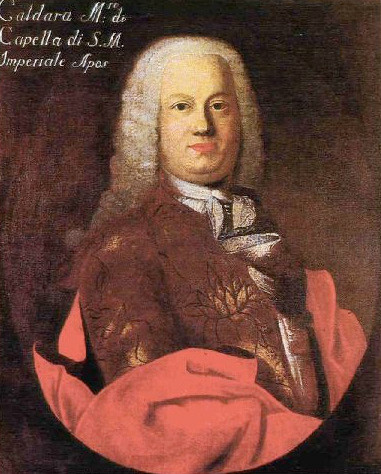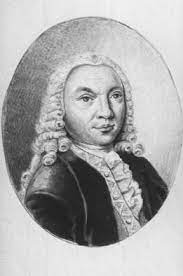

Antonio Caldara
Born: 1670Died: 1736
Education: a chorister at St Mark's in Venice, under the instruction of Giovanni Legrenzi
Career: maestro di cappella to the inept Charles IV, Duke of Mantua, a pensionary of France
Antonio Caldara was an Italian Baroque composer. He was the son of Giuseppe Caldara, a local violinist of no great fame. In his childhood, Caldara was a choirboy at St. Mark's Cathedral in Venice and also studied the viol, the cello, and keyboard. He may well have been a pupil of the maestro di cappella of St. Mark's, Giovanni Legrenzi, but this is uncertain. By 1689 he was known as a cellist and his growing number of compositions included operas, sonatas da chiesa and da camera, and solo cantatas. Performances of his operas had been given at Venice and Rome by the early 1690's and a personal visit made to Rome towards the end of the 17th century, about this time implies an acquaintance with and perhaps instruction from Corelli, Aless, Scarlatti and Pasquini. He returned to Venice around 1698. In 1699, Antonio Caldara left Venice for Mantua: he was appointed maestro di cappella da chiesa e dal teatro to Ferdinando Carlo (Charles IV), the Duke of Mantua, a pensionary of France with a French wife, who took the French side in the War of the Spanish Succession. The Duke had a reputation for a dedication to grandiose opera productions, the cost of which threw the finances of Mantua into disarray. It is difficult to determine exactly what Caldara was doing during the period of his employment with the Duke, for virtually none of his music from this time survives. Caldara remained in the Duke's service until 1707; the Duke died mysteriously the following year. In 1708, Caldara was in Rome; while there, he composed of church music and oratorios for Cardinal Ottoboni, and became acquainted with such luminaries as Georg Frideric Handel, Alessandro Scarlatti and Domenico Scarlatti, and Antonio Corelli. In this same year, Caldara also composed a number of operas, including Sofonisba. Later in 1708, Antonio Caldara departed for Barcelona and his first association with the Habsburg dynasty in the person of the Archduke Charles (Charles III). The performance of Caldara's Componimento da camera per musica: Il più bel nome nei festeggiarsi il Nome Felicissimo di Sua Maesta Cattolica Elisabetha Christina Regina delle Spagne at the celebration of Charles' marriage to Elisabeth Christine of Braunschweig-Lüneburg (Barcelona, August 1708) firmly established him as a favourite and despite his return to Rome to take up the position as Maestro di Cappella to Francesco Maria Ruspoli, Prince of Cerveteri (July 1709), contact with the Spanish Court was not broken. Indeed, as later developments proved, it was a most fortunate connection. In the light of Ruspoli's eminence as a patron of the arts, Caldara's appointment as director of the noblemans, distinguished band of virtuosi di canto e suono is proof of an established fame. From his compositional output during the next seven years it is clear that Caldara's muse flourished in this more stable environment and he composed mainly secular works including 150 solo cantatas, over 50 duets, four operas and nine oratorios. After marrying contralto Caterina Petrolli, Caldara left Rome in 1711, travelling to Vienna and Milan, then returning to Rome to fulfil his duties to the Prince. Between 1711 and 1715, Caldara composed, among other things, a significant collection of two and three voice motets. Yet despite an obviously secure position, the news of the death of the Habsburg Emperor Joseph I (April, 1711) and the proclamation of his brother Charles III of Spain as Charles VI, Holy Roman Emperor, brought Caldara to Vienna hoping that the earlier favouritism would secure a court appointment. In the event, the present Vice-Kapellmeister Marc' Antonio Ziani had been made Kapellmeister before Caldara's arrival; Johann Joseph Fux secured the post of Vice-Kapellmeister. Caldara returned to his position in Rome - retained by means of a steady flow of compositions from Vienna - but not before making a detour through Salzburg to court the favour of Franz Anton von Harrach, the Prince-archbishop. A reshuffling of posts at the Imperial Court upon Ziani's death in 1715 and a more or less firm promise of an appointment brought about Caldara's final break with Rome. He was appointed Vice-Kapellmeister to Charles VI in 1717 (J.J. Fux became Kapellmeister). He e left Rome for good in 1716, after composing some cantatas for his former patron, Prince Ruspoli, and settled in Vienna. Once in Vienna, Caldara was faced with a demanding new position in which he was required to compose many large and small-scale dramatic works each year, including many operas and oratorios. In addition to his busy schedule, Caldara also accepted outside commissions, composing operas for nobles in Salzburg and Monrovia. He was well-respected and well-paid in Vienna (though he had a reputation for lavish spending), and was able to be active as a composer until his death in December 1736. The compositions of these last twenty years were prolific in number, diverse in genre, often brilliant and certainly never less than highly competent in quality, mature and personal in expression and style, and above all, secured for Caldara a European fame that lasted long after his death. Antonio Caldara is chiefly known as a composer of vocal music (operas, cantatas and oratorios), and is especially remembered for his operas, many of which are settings of librettos by Zeno and Metasasio. His stylistic development as a composer, however, has been described as a movement from works that are carefully crafted, with attention given to both musical and dramatic elements (his pre-1716 works) to music that becomes increasingly less detailed and texturally thinner (post-1716), reflecting Caldara's pressing schedule in Vienna. Today, manuscripts of Caldara's music are widely dispersed across Europe but his compositions which record so valuable a picture of the late Baroque in Italy and Austria are comparatively unknown to performers and little studied by scholars. Noted Works Maddalena ai piedi di Cristo (Oratorio, c. 1700) Santo Stefano, primo Re d'Ungheria (Oratorio, 1713) La Conversione di Clodoveo Re di Francia (Oratorio, 1715) La Passione di Gesù Cristo Signor Nostro (Oratorio, 1716) Sebben, crudele (Aria) D'improvviso (Cantata) Pur Dicesti, O Bocca Bella (Aria) Alma Del Core (Aria) Selve amiche (Aria)

